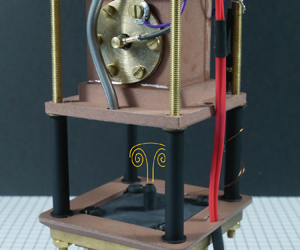Article contents
Coherent propagation of vortex rings at extremely high Reynolds numbers
Published online by Cambridge University Press: 09 December 2022
Abstract

We take advantage of the extremely small kinematic viscosity of superfluid  $^4$He to investigate the propagation of macroscopic vortex rings at Reynolds numbers between
$^4$He to investigate the propagation of macroscopic vortex rings at Reynolds numbers between  $2 \times 10^4$ and
$2 \times 10^4$ and  $4 \times 10^6$. These inhomogeneous flow structures are thermally generated by releasing short power pulses into a small volume of liquid, open to the surrounding bath through a vertical tube
$4 \times 10^6$. These inhomogeneous flow structures are thermally generated by releasing short power pulses into a small volume of liquid, open to the surrounding bath through a vertical tube  $2$ mm in diameter. We study specifically the ring behaviour between
$2$ mm in diameter. We study specifically the ring behaviour between  $1.30$ and
$1.30$ and  $1.80$ K using the flow visualization and second sound attenuation techniques. From the obtained data sets, containing more than
$1.80$ K using the flow visualization and second sound attenuation techniques. From the obtained data sets, containing more than  $2600$ realizations, we find that the rings remain well-defined in space and time for distances up to at least
$2600$ realizations, we find that the rings remain well-defined in space and time for distances up to at least  $40$ tube diameters, and that their circulation depends significantly on the travelled distance, in a way similar to that observed for turbulent vortex rings propagating in Newtonian fluids. Additionally, the ring velocity and circulation appear to be influenced solely by a single, experimentally accessible parameter, combining the liquid temperature with the magnitude and duration of the power pulse. Overall, our results support the view that macroscopic vortex rings moving in superfluid
$40$ tube diameters, and that their circulation depends significantly on the travelled distance, in a way similar to that observed for turbulent vortex rings propagating in Newtonian fluids. Additionally, the ring velocity and circulation appear to be influenced solely by a single, experimentally accessible parameter, combining the liquid temperature with the magnitude and duration of the power pulse. Overall, our results support the view that macroscopic vortex rings moving in superfluid  $^4$He closely resemble their Newtonian analogues, at least in the absence of significant thermal effects and at sufficiently large flow scales.
$^4$He closely resemble their Newtonian analogues, at least in the absence of significant thermal effects and at sufficiently large flow scales.
Information
- Type
- JFM Papers
- Information
- Copyright
- © The Author(s), 2022. Published by Cambridge University Press
References
REFERENCES
- 3
- Cited by


